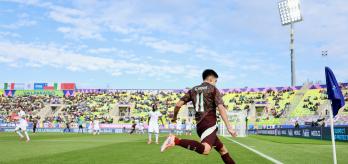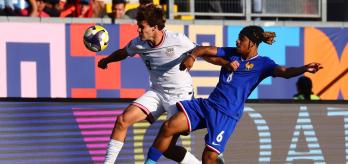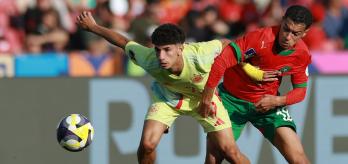For developing players, learning and understanding the triggers to play from in-transition phases is key to their growth, as they learn about roles and responsibilities and how they can change as these situations unfold.
Our Technical Study Group and Football Performance Insights Team are in Chile for the FIFA U-20 World Cup 2025™. In this article, former Chile national team player Marcelo Jara explains how the USA used their pressing strategy to create goalscoring chances against France and how the players adapted this strategy to both a high press and a mid-block.
PRINCIPLES OF THE USA’S PRESS
-
Clear roles and responsibilities for all outfield players, with the additional understanding and awareness of other players’ roles.
-
Commitment to press as a team and trust that everyone fulfils their role.
-
Apply the press in different defensive phases with coordinated intensity.
-
Capitalise on the opposition’s open team shape by playing early balls through their defensive line after transition to attack.
In this game, France used a very wide team shape, ranking in the top 2% of all teams for in-possession team width in both the FIFA U-20 World Cup 2023™ and the FIFA U-20 World Cup 2025 up to this match. While this width was intended to stretch the USA’s defence, it also left space during defensive transitions that the USA could exploit.
The USA actively targeted this space and had been very successful at breaking through opponents’ defensive lines. At this stage in the tournament, they ranked in the top 5% of teams for receptions from line-breaking passes and in the top 2% for the proportion of offers made to receive inside the opposition’s team shape, with 64%.
TRANSITION FROM HIGH PRESS
The USA were intent on using their pressing strategy when France were setting up for their goal kicks, as they spent 12% of their out-of-possession time in a high block. In the first half, France demonstrated a desire to initially play short from their goal kicks, before playing longer passes, targeting attacking players in high positions in the wide areas. As can be seen in the image below, France used a very wide team shape, while the USA adopted a 1-4-1-4-1 pressing structure with players having clear, defined roles. They generally allowed the first pass with a ball played to a French full-back, triggering the press.
The key roles and responsibilities within the USA’s 1-4-1-4-1 pressing structure were as follows:
-
Centre-forward positioned high to dictate the direction of play, forcing France to play down the same side as their first pass;
-
Two advanced midfielders cover France’s double-pivot players;
-
Wide midfielder nearest the ball presses the French full-back aggressively if the ball is played to them;
-
Defensive midfielder locks on to France’s attacking midfielder and protects space in front of the back four;
-
Full-backs lock onto France’s wide forwards;
-
One centre-back marks France’s centre-forward tightly;
-
The second centre-back acts as a +1 to provide cover in behind if/when the ball-side centre-back and full-back become fully engaged in 1v1 defending.
According to TSG expert Jara, the USA’s press was full of intention, with players demonstrating a clear understanding of their roles, not only during the defending phase but also in the attacking transition phase.
“The USA were consistent in their pressing approach, but in the second half, they executed their press with greater intensity and efficiency. France looked for width and depth in their team shape, so the positioning of the USA’s defenders was crucial to how they defended. They knew the ball was coming long, and their defenders were tight to France’s forward players and fully prepared to be aggressive with great defensive control in risky situations. They showed great confidence and trust in each other, knowing that their defensive midfielder was protecting the space diligently in front of them while their free centre-back was covering the space in behind.
“In clips 1 and 2, we see how clear the players were in understanding their roles and responsibilities on both sides, and the effectiveness teams can have in these moments. When they win the ball, they take their time to release the ball forward, showing that coordinated and anticipated turnovers can lead to dangerous attacking situations when the timing of support runs and the forward pass align.”
TRANSITION FROM MID-BLOCK
The same pressing principles were used by the USA when defending in the mid-block phase, using the 1-4-1-4-1 structure in a very compact shape. By the time this match was played, only Norway had used a shorter mid-block team shape than the USA, whose average shape was just 21.4 metres long and 37.9 metres wide.
In clip 3 below, Jara highlights the consistency in the intensity of the USA’s press when in the mid-block phase, but also the players’ awareness of each other’s roles.
“The 1-4-1-4-1 setup is the same, but when the right-back has to engage in the press fully, we see immediately how the right midfielder covers the space. This happens on both sides after France change their side of attack. When the USA win the ball back, there is a considered pause before they play the ball forward, allowing time for support runners. The body shape of their centre-midfielder, who receives the ball on the attacking transition, is so important because he sets the intention and space for the other players to make the forward runs before he also makes his attacking run. He also shows great game intelligence by changing the speed and timing of his run to meet the cross.”
Developmental points
An important aspect in the development of young players is their ability to understand not just their own roles, but also those of their team-mates in different tactical strategies. Transitioning from in-possession phases to out-of-possession phases (and vice versa) requires high levels of concentration and mental engagement.
Understanding roles and responsibilities is vital to initiate a coordinated team press, as is the capacity of individual players to execute their own tasks while also recognising when they need to prioritise covering for others.
As in-game situations change quickly from defending phases to attacking phases, players need to develop their capacity to make fast decisions and possess the game awareness to respond quickly with good timing and coordination to capitalise on the opportunity to exploit vulnerabilities in the opposition’s shape at the time of transition.















